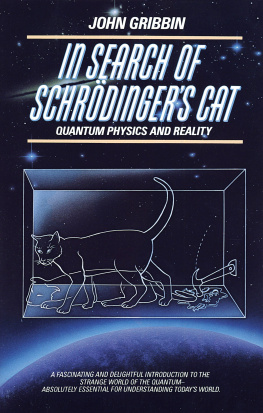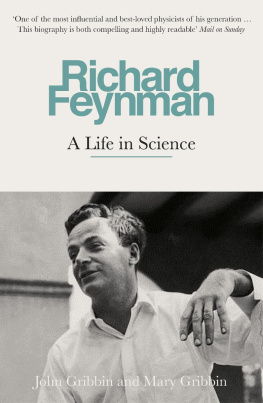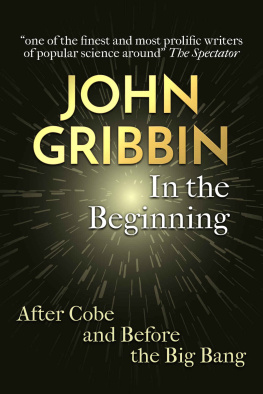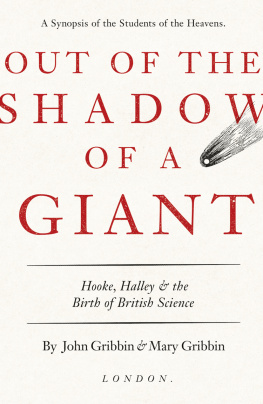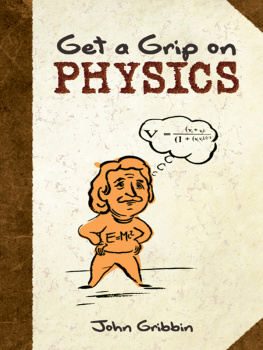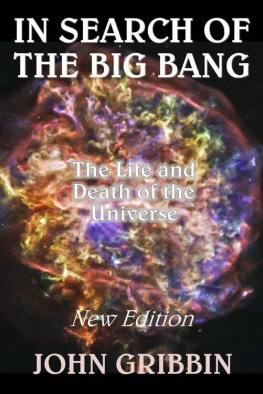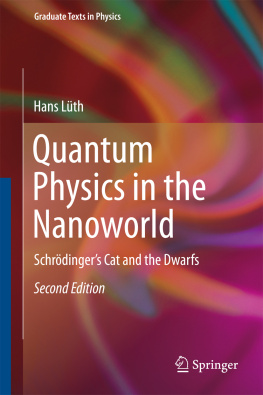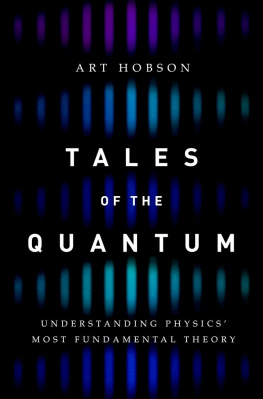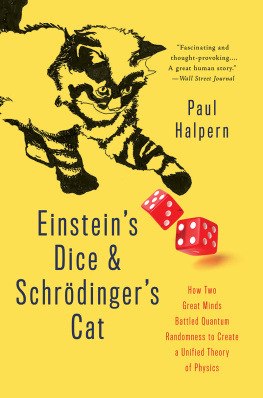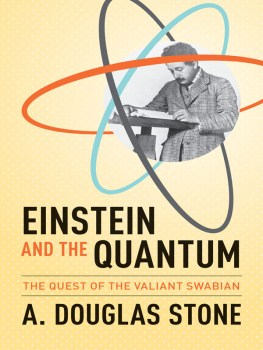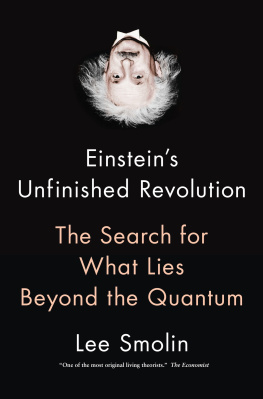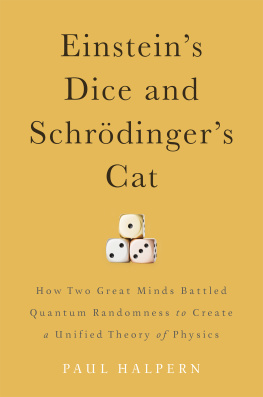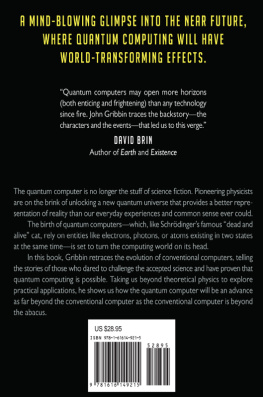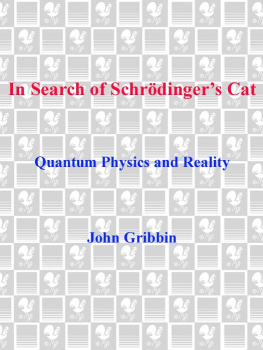IN SEARCH OF SCHRDINGERS CAT:
QUANTUM PHYSICS AND REALITY
A Bantam Book / September 1984
All rights reserved.
Copyright 1984 by John and Mary Gribbin.
No part of this book may be reproduced or transmitted in any form or by any means, electronic or mechanical, including photocopying, recording, or by any information storage and retrieval system, without permission in writing from the publisher.
For information address: Bantam Books.
Library of Congress Cataloging-in-Publication Data
Gribbin, John R.
In search of Schrdingers cat.
Bibliography: .
1. Quantum theoryHistory. 2. Reality.
3. Schrdinger, Erwin, 18871961. 1. Title.
QC173.98G75 1984 530.1209 84-2975
eISBN: 978-0-307-79044-6
Published simultaneously in the United States and Canada
Bantam Books are published by Bantam Books, a division of Bantam Doubleday Dell Publishing Group, Inc. Its trademark, consisting of the words Bantam Books and the portrayal of a rooster, is Registered in U.S. Patent and Trademark Office and in other countries. Marca Registrada. Bantam Books, 1540 Broadway, New York, New York 10036.
v3.1
I dont like it and Im sorry I ever had anything to do with it.
ERWIN SCHRDINGER
18871961
Nothing is real.
JOHN LENNON
19401980
ACKNOWLEDGMENTS
My acquaintance with quantum theory goes back more than twenty years to my school days, when I discovered the magical way in which the electron-shell model of the atom explained the periodic table of the elements and virtually all of the chemistry that I had struggled with through many a tedious lesson. Following up this discovery for myself with the aid of library books allegedly too far advanced for my modest scholastic level, I immediately discovered the beautiful simplicity of the quantum theorys explanation of atomic spectra, and experienced for the first time the revelation that the best things in science are both beautiful and simple, a fact that all too many teachers conceal from their students, by accident or design. I felt like the character in C. P. Snows The Searchwhich I only read much laterwho discovers much the same thing:
I saw a medley of haphazard facts fall into line and order But its true, I said to myself. Its very beautiful. And its true. (Macmillan edition, 1963, page 27.)
Partly as a result of this insight, I decided to read physics at university. In due course the ambition was fulfilled, and I became an undergraduate at the University of Sussex in Brighton. But there, the simplicity and beauty of the underlying ideas was smothered in a wealth of detail and mathematical recipes for solving specific problems with the aid of the equations of quantum mechanics. Applying these ideas in the world of physics today seemed to bear as much relevance to the underlying truth and beauty as piloting a 747 must bear to hang gliding, and although the power of that initial insight remained as a major influence in my career, for a long time I neglected the quantum world and explored other scientific pastures.
The fires of that early interest were rekindled by a combination of factors. In the late 1970s and early 1980s, books and articles began to appear attempting, with varying success, to introduce the strange world of the quantum to a nonscientific audience. Some of these alleged popularizations were so outrageously far from the truth that I could not imagine any reader discovering the truth and beauty of science by reading them, and I began to feel moved to do the job properly. At the same time, news was coming in of the continuing series of experiments that has now established the reality of some of the strangest features of quantum theory, and that news inspired me to delve back into the libraries and refresh my understanding of those strange ideas. Finally, one Christmas I was asked by the BBC to appear on a radio program as a kind of scientific counterweight to Malcolm Muggeridge, who had recently announced his conversion to the Catholic faith and was the principal guest at the time of this festival. After the great man had had his say, emphasizing the mysteries of Christianity, he turned to me and said but heres the man who knows all the answers, or claims to know all the answers. In the limited time at my disposal, I endeavored to respond in kind, pointing out that science does not claim to have all the answers, and that it is religion, not science, that depends essentially on absolute faith and conviction that the truth is known. I dont believe anything, I said, and was about to expand on this philosophy when the program came to an end. All through the festive season, I was greeted by both friends and acquaintances with an echo of those words, and spent hours explaining that my lack of absolute faith in anything did not prevent me from leading a normal life making use of such reasonable working hypotheses as the likelihood that the sun wont disappear overnight.
The process crystalized my thoughts on what science is all about, and involved a lot of discussion of the basic realityor unrealityof the quantum world, enough to convince me that I really was ready to write the book you now hold. While preparing the book, I tried out many of the more subtle arguments in my regular scientific contributions to a radio show hosted by Tommy Vance and broadcast by the British Forces Broadcasting Service; Toms probing questions soon uncovered deficiencies in my presentation, and resulted in a better organization of my ideas. The main source of the reference material used in preparing the book was the library of the University of Sussex, which must have one of the best collections of books on quantum theory anywhere, and some more obscure references were tracked down for me by Mandy Caplin, of New Scientist, who has a persuasive way with telex messages, while Christine Sutton straightened out some of my misconceptions about particle physics and field theory. My wife not only provided the essential backup in terms of literary research and organization of the material, but smoothed out many of the rough edges. I am grateful also to Professor Rudolf Peierls for taking the trouble to explain to me in detail some of the subtleties of the Clock in the Box experiment and the EPR Paradox.
So any praise for the good qualities in this book should be laid at the doors of: the advanced chemistry texts, whose titles I now forget, that I found in the Kent County Library at the age of sixteen; the misguided popularizers and publicists for quantum ideas, who convinced me that I could do it better; Malcom Muggeridge and the BBC; the University of Sussex library; Tommy Vance and BFBS; Mandy Caplin and Christine Sutton; and especially Min. Any complaints concerning the remaining deficiencies in the book should, of course, be addressed to me.
JOHN GRIBBINS
July 1983
CONTENTS
;
; Is the Universe a Vacuum
Fluctuation?;
INTRODUCTION
If all the books and articles written for the layman about relativity theory were laid end to end, theyd probably reach from here to the moon. Everybody knows that Einsteins theory of relativity is the greatest achievement of twentieth-century science, and everybody is wrong. But if all the books and articles written for the layman about quantum theory were laid end to end, theyd just about cover my desk. That doesnt mean that quantum theory is unheard of outside the halls of academe. Indeed, quantum mechanics has become highly popular in some quarters, being invoked to explain phenomena such as telepathy and spoon bending, and providing a fruitful input of ideas for several science fiction stories. Quantum mechanics is identified in popular mythology, so far as it is identified at all, with the occult and ESP, some weird and esoteric branch of science that nobody understands and nobody has any practical use for.

